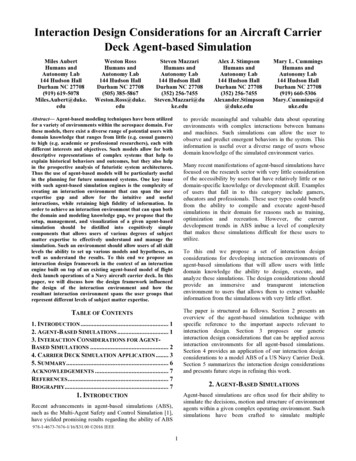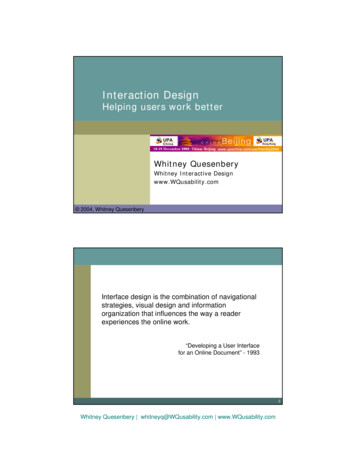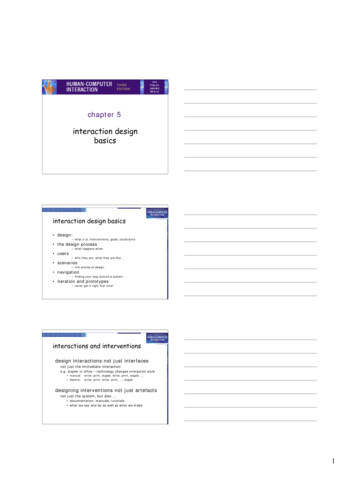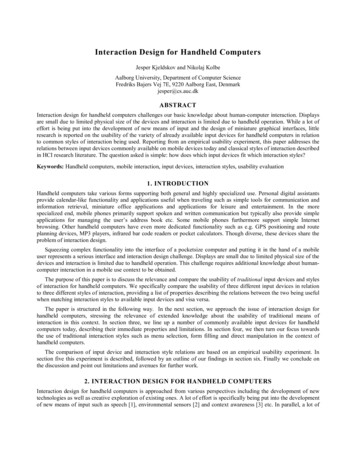
Transcription
Interaction Design Considerations for an Aircraft CarrierDeck Agent-based SimulationMiles AubertHumans andAutonomy Lab144 Hudson HallDurham NC 27708(919) 619-5078Miles.Aubert@duke.eduWeston RossHumans andAutonomy Lab144 Hudson HallDurham NC 27708(505) 385-5867Weston.Ross@duke.eduSteven MazzariHumans andAutonomy Lab144 Hudson HallDurham NC 27708(352) 256-7455Steven.Mazzari@duke.eduAlex J. StimpsonHumans andAutonomy Lab144 Hudson HallDurham NC 27708(352) 256-7455Alexander.Stimpson@duke.eduMary L. CummingsHumans andAutonomy Lab144 Hudson HallDurham NC 27708(919) 660-5306Mary.Cummings@duke.eduAbstract— Agent-based modeling techniques have been utilizedfor a variety of environments within the aerospace domain. Forthese models, there exist a diverse range of potential users withdomain knowledge that ranges from little (e.g. casual gamers)to high (e.g. academic or professional researchers), each withdifferent interests and objectives. Such models allow for bothdescriptive representations of complex systems that help toexplain historical behaviors and outcomes, but they also helpin the prospective analysis of futuristic system architectures.Thus the use of agent-based models will be particularly usefulin the planning for future unmanned systems. One key issuewith such agent-based simulation engines is the complexity ofcreating an interaction environment that can span the userexpertise gap and allow for the intuitive and usefulinteractions, while retaining high fidelity of information. Inorder to achieve an interaction environment that can span boththe domain and modeling knowledge gap, we propose that thesetup, management, and visualization of a given agent-basedsimulation should be distilled into cognitively simplecomponents that allows users of various degrees of subjectmatter expertise to effectively understand and manage thesimulation. Such an environment should allow users of all skilllevels the ability to set up various models and hypotheses, aswell as understand the results. To this end we propose aninteraction design framework in the context of an interactionengine built on top of an existing agent-based model of flightdeck launch operations of a Navy aircraft carrier deck. In thispaper, we will discuss how the design framework influencedthe design of the interaction environment and how theresultant interaction environment spans the user groups thatrepresent different levels of subject matter expertise.to provide meaningful and valuable data about operatingenvironments with complex interactions between humansand machines. Such simulations can allow the user toobserve and predict emergent behaviors in the system. Thisinformation is useful over a diverse range of users whosedomain knowledge of the simulated environment varies.TABLE OF CONTENTSThe paper is structured as follows. Section 2 presents anoverview of the agent-based simulation technique withspecific reference to the important aspects relevant tointeraction design. Section 3 proposes our genericinteraction design considerations that can be applied acrossinteraction environments for all agent-based simulations.Section 4 provides an application of our interaction designconsiderations to a model ABS of a US Navy Carrier Deck.Section 5 summarizes the interaction design considerationsand presents future steps in refining this work.Many recent manifestations of agent-based simulations havefocused on the research sector with very little considerationof the accessibility by users that have relatively little or nodomain-specific knowledge or development skill. Examplesof users that fall in to this category include gamers,educators and professionals. These user types could benefitfrom the ability to compile and execute agent-basedsimulations in their domain for reasons such as training,optimization and recreation. However, the currentdevelopment trends in ABS imbue a level of complexitythat makes these simulations difficult for these users toutilize.To this end we propose a set of interaction designconsiderations for developing interaction environments ofagent-based simulations that will allow users with littledomain knowledge the ability to design, execute, andanalyze these simulations. The design considerations shouldprovide an immersive and transparent interactionenvironment to users that allows them to extract valuableinformation from the simulations with very little effort.1. INTRODUCTION . 12. AGENT-BASED SIMULATIONS . 13. INTERACTION CONSIDERATIONS FOR AGENTBASED SIMULATIONS . 24. CARRIER DECK SIMULATION APPLICATION . 35. SUMMARY. 6ACKNOWLEDGEMENTS . 7REFERENCES . 7BIOGRAPHY. 72. AGENT-BASED SIMULATIONS1. INTRODUCTIONAgent-based simulations are often used for their ability tosimulate the decisions, motion and structure of environmentagents within a given complex operating environment. Suchsimulations have been crafted to simulate multipleRecent advancements in agent-based simulations (ABS),such as the Multi-Agent Safety and Control Simulation [1],have yielded promising results regarding the ability of ABS978-1-4673-7676-1/16/ 31.00 2016 IEEE1
aerospace operating environments with success such as thecarrier deck of a US Navy Aircraft Carrier [1] or airtransportation [2]. Agents within ABS are modeledindividually each with their own set of behaviors to beexecuted under certain stimuli.square node in the tree represents a control group or pagethat contains controls for setting associated represented bythe circular nodes. This tree structure allows users toassociate the variables with their respective agents or agentgroups.ABS can offer a wealth of information regarding its agents,how they interact and the potential impact of theseinteractions at the system level. However in most existingsimulation environments this information is buried in linesof code and large data files [3], diminishing the ability ofusers to locate and utilize this information in a meaningfulway.Each agent-based simulation has three separate phases fromstart to completion. The first is the setup phase, whichconsists purely of setting up variables and parameters thatdefine the simulation. For a typical ABS, these includenumber of agents, the respective agent types and underlyinginformation that govern agents’ actions. The second phase isthe execution, which consists of the actual simulation ofeach agent and their respective actions, behaviors, andinteractions. The third and final phase is the analysis. This iswhere the simulation computes specified results from theinteractions that occurred during the simulation. These threephases are fundamental for users to develop, run andanalyze agent-based simulations.Figure 1: Variable Association Grouping TreeThe second key design consideration is that of setupprogress. Setup progress is the ability of the setupenvironment to allow the user to determine if all requiredvariables and parameters have been initialized. In order toprovide this feedback to users of the simulation environmenta summary of the specified agent specific simulationvariables can be presented to the user in a format similar tothe tress shown in Figure 1. By presenting this summaryinformation to the user they will have the ability to quicklyidentify that all variables have been initialized correctlybefore executing the simulation.3. INTERACTION CONSIDERATIONS FOR AGENTBASED SIMULATIONSIn order to provide users with an intuitive interactionenvironment for ABS representations, we propose aframework of interaction design considerations based on thethree core phases of agent-based simulations. Theconsiderations for each of these three steps are as follows:In summary, in order to create an intuitive setupenvironment that invariant of developer skill or domainspecific knowledge the user must be able to understand howto setup the simulation they desire, including the numbersand types of agents, and ensure the input settings arecorrect.SetupIn the setup phase, the user should be given the ability tospecify all simulation parameters and attributes, such as thenumber and type of agents, behavioral aspects of the agentssuch as task occurrence rates and agent movement rates, andenvironmental factors such as simulation speed. In order toallow users with minimal domain-specific knowledge tosuccessfully setup and compile such a simulation, there aretwo key design considerations that need to be addressed.ExecutionThe execution phase of agent-based simulations consists ofproviding the user real-time access to the simulation. Thisreal-time access allows the user to both monitor thedevelopment of events within the simulation and introducechanges in behavior at run time to investigate how thesechanges impact agent and system-level performance. Inorder to support the user’s ability to inject events in realtime, there are three key interaction design considerations:situational awareness, environment manipulation andinteraction impact.The first design consideration that needs to be addressed isvariable association, which is how well a given user is ableto associate an action with its impact on the agents withinthe simulation. This is especially important for users withlittle domain-specific knowledge, as they may notunderstand which variables correspond to which agents orwhether a variable is agent-specific or global to the system.In order to address this issue during setup, agents withsimilar attributes and behaviors should be grouped togetherinto separate interactive domains (such as different screensor panels within a screen). This segmentation process can bedescribed by a tree-like structure as shown in Figure 1, eachThe first key interaction design consideration is simulationsituational awareness. Situational awareness within anagent-based simulation means that a given user must at anytime step be able to perceive, comprehend and project [4]the behavior of any given agent within the simulation. Thisawareness is extremely important for users to gainconfidence in the system. To this end, we propose a “fullyinteractive” visualization of the simulation environment.2
The core features include a visualization of each agentwithin the environment, the ability to query any agent andview its current behavior, and providing constant feedbackto the user about agents’ states in the current simulation.The final design consideration concerns how to presentresults relevant to analysis to the user. When presentingsummary information, it is important to ensure that the usercan understand the presented information in the context ofthe simulation. Special consideration needs to be placed onusing controls that can effectively relate this informationback to the simulation. Such user controls should generallyconsist of visual plots of information that can directly berelated back to the simulation environment.During execution users must be able to initiate andcomprehend the impact of a user-initiated behaviors.Simulations that provide no interaction component in realtime appear as black boxes to users. A better approach is toallow users to introduce events to stress test the system ordetermine a specific response for verification and validation.In order to achieve this, there are two design considerations.First, the user must be able to directly perceive the impact ofthe initiated event of the simulation environment. This canbe achieved by highlighting all affected agents within thesimulation environment. The second consideration requireslinking the visualization of the impact of the user’sinteraction, thereby providing confirmation feedback.In summary, during the analysis phase of agent-basedsimulations it is important to provide users the necessaryinformation to abstract and reason upon what happened inthe simulation through exploring the simulation events andproviding information regarding the local and global impactof each agent behavior within the simulation.4. CARRIER DECK SIMULATION APPLICATIONIn order to illustrate the proposed interaction designconsiderations in the context of a real agent-basedsimulation, they are applied to an agent-based simulation offlight deck operations on a US navy aircraft carrier.In summary, during live execution, each user must haveawareness of each agent within the simulation andunderstand the impact of each interaction on live behaviorof the simulation environment and all of its modeled agents.In addition, it is critical to allow the user the ability toinitiate events in real-time to better understand thesimulations.The implemented interaction environment is design to spanfour key user groups. First with zero domain specificknowledge are non-military personnel looking to learn aboutcarrier deck operation. Second with low domain specificknowledge are baby carrier deck personnel looking toevaluate their tasks during certain carrier deck operations.Thirdly with high level domain specific knowledge areranking US Navy personnel that are looking for an overviewof current carrier deck operations. Finally with high domainspecific knowledge Navy researchers looking to preformdetailed analyses of carrier deck operations.AnalysisThe analysis phase of agent-based simulation is centered onthe ability for a user to analyze the results of a previouslyexecuted simulation. During the analysis phase users shouldbe able review simulations at varying levels of detail thatrange from overview summaries to low level temporalbehaviors of all simulation agents. To provide a user accessto both high and low level information for analysis, wepropose three key interaction design considerations(simulation playback, event tagging and simulationsummary).The section is structured with an overview of theimplemented carrier deck simulation environment firstfollowed by a summary of the implemented interactionenvironment for the simulation based on the proposedinteraction design considerations.During a low-level analysis of a simulation, it is essential toprovide users the ability to examine the behavior of eachsimulation agent throughout the simulation lifecycle inorder to promote a deeper understanding of agent behaviors.Thus we propose a replay function to allow users to scrollthrough a simulation and analyze each time step. The replayenvironment should be flexible, allowing the user to moveboth forwards and backwards through simulation time,allowing for the selection of a particular moment in time inorder to view agent states.Overview of the Carrier Deck Simulation EnvironmentThe simulation of US navy aircraft carrier deck operationscalled Personnel Multi-Agent Safety and Control Simulation(PMASCS) [1,2,6] is a stochastic ABS of carrier deckoperations during launch cycles. The simulation is builtupon the Golden T Game Engine (GTGE) programminglibrary and developed in Java. Three agent types aremodeled: aircraft, catapults, and crewmen. Included are twoaircraft types, F-18 (fighter jet) and E-2 (support propeller),nine crewman types: aircraft directors, aircraft captains,chocks and chains, weight-board checkers, maintenancecrew, top side petty officers, fueling crew, safety officers,and ordnance crew, and two failure types: catapult failuresand maintenance failures.The second design consideration concerns key eventtagging. Key event tagging is a method of providing users alist of key events within the simulation to allow for efficienttraversal through the simulation. By tagging key eventswithin an agent-based simulation, users will be able toquickly locate relevant parts of the simulation. These eventsindicate key turning points within a simulation and thereforeprovide users information regarding how these eventsimpacted the simulation.Each agent has their behavior defined as a set of actions thatare a function of the state of the simulation and the states of3
other agents. Two types of actions exist, abstract and basicactions. Basic actions include simple movements such as"Walk", "Run", or "Wait." Abstract actions are morecomplex and consist of a queue of basic actions. Commonabstract actions are "Fuel Aircraft", "Perform Maintenance",or "Taxi to Catapult." For example, the maintenance crewactions include maintenance on aircraft and catapults [5],each of which is triggered respectively when an aircraftfailure is discovered or a catapult fails. They can occur atrandom times, determined from sampling a uniformdistribution over the entire preparation cycle, or at specifictimes as desired by the user.Overview of the ABS Carrier Deck Interaction EnvironmentBuilding upon PMASCS, we developed an interactionenvironment that provides separate interfaces to handle thesetup, execution, and analysis of the ABS, as described inSection 3. We call this interactive environment “PriFly,”which simulates the primary flight control environment thatexists onboard carriers today. The simulation setup interfacesets and compiles all relevant variables for the carrier deckagents. The execution interface shows real-timevisualizations of the simulation, and allows for userinteraction. The analysis interface provides both summaryand review information to the user.For example, a maintenance agent recognizes that a failurehas occurred and performs a repair. The time to perform arepair is pulled from a log-normal distribution, which hasbeen shown to estimate well the task completion time forpeople [6,7]. In a similar way, all agents in the simulationinteract with one another to handle eleven event types;failures, maintenance, fueling, taxiing, un-chocking aircraft,chocking of aircraft, ordnance attachment, weight boardchecks, holdback bar installation, and launches.Application of Setup Interaction ConsiderationsThe first interaction window handles the setup of the carrierdeck simulation. According to the proposed designconsiderations, an important aspect is to partition the agenttypes and their respective variables in to a tree like structureas shown in Figure 2. The square nodes in the structurerepresent agent groups and agents which are implemented aspages or control groups, the circular nodes represent agentvariables, those with solid lines are fixed variables and notvisually represented in the interaction environment andthose with a dashed line represent variables that can be setby the user and are implemented with an active user control.The simulation records two primary types of metrics forsafety and operation efficiency: halo violations and sortielaunch times, respectively. Halo violations are a measure ofrisk to personnel and aircraft determined by their proximityto one another. When an operator comes within a range ofan aircraft determined to be dangerous, called the primaryhalo radius of the aircraft, a person-to-aircraft halo violationoccurs. A primary halo radius is defined by the circle ofradius R from the center of the aircraft, where R is thewingspan of the aircraft. Similarly, when an aircraft comeswithin one primary halo radius of another aircraft, anaircraft-to-aircraft halo violation occurs. The duration ofeach halo violation is recorded as well. Sortie launch timeis the total time required to launch all aircraft from parkedpositions in the launch cycle, beginning with the launchingof the first aircraft and ending with the launching of the lastaircraft, and is a primary metric of operational efficiency.This structure shows there are three simulation attributesthat need to be set up (aircraft, personnel and failures) andeach agent within the agent type groups has its respectivevariables (represented by the dashed circles) that control itspresence and behavior within the simulation.Visually the agent group partition layer of the tree is shownin Figure 3. This interaction window has three clickableareas for each of the agent type groups that take you to therespective agent group setup page. Also this windowcontains a control to set the number of times this simulationwill execute.Figure 2: Agent Type-Variable Tree Structure4
Figure 6: Unset (Left) and Set (Right) Partition GroupsApplication of Execution Interaction ConsiderationsThe primary design consideration we proposed for thisphase was promotion of situational awareness. In order tomeet the three components of situational awareness(perception, comprehension and projection) for the carrierdeck simulation, an interactive visualization window wasimplementedasshowninFigure7andFigure 8. This visualization window is available in the livemode (Figure 7) and shows all of the assets on deck inmotion and how they are interacting with each other per theABS. This allows for users to perceive the active behaviorsof all agents within the simulation.Figure 3: Agent Group Partitions PageThe aircraft and failure setup group pages in Figure 4 showhow the individual agent types are separated with theirrelevant variables within the group setup page. For Aircraftsetup there are two aircraft types (F-18 and E-2), eachaircraft has two permanent variables (taxi speed andwingspan), which are unseen, and one flexible variable(agent count), which each aircraft group has a control to set.For failures, the two failure types (Catapult Failure andMaintenance Failure) each have a control to set the failureprobability for the simulation.Figure 4: Aircraft Agent Group Setup Page (Left) andFailure Agent Group Setup Page (Right)Figure 7: Visualization Page in Live Stream ModeThe personnel setup group page (shown in Figure 5) offers amore complex variable association problem. The walkingspeed is a global variable across all personnel types, asshown in Figure 5. As discussed in Section 3, the user mustunderstand the setup progress and allow for clearunderstanding of the dependency of agent group types oneach other. When applied to the carrier deck simulation thiscan be achieved by summarizing the agent settings on theagent group partition page demonstrated in Figure 6.In order to achieve meaningful comprehension, users canpause the simulation to enter agent exploration mode asshowninFigure 8. When in the agent exploration mode, which canonly be accessed in a paused live simulation, users are ableto click on any agent within the simulation to reveal theagent type and information regarding their current behavior,specifically their current task and the current associatederror. This information allows users to project what eachagent will be doing in the next time step.Figure 5: Personnel Agent Group Setup PageFigure 8: Visualization Page in Agent Exploration Mode5
The implemented carrier deck simulation allows the user toinitiate two real-time failures (catapult failures andmaintenance failures), represented on the visualizationwindow (Figure 7). According to the proposed designconsideration framework, each of these controls whenclicked triggers a failure that is processed by the simulationenvironment. This failure is in addition to the failuresalready generated in the setup mode, and is introduced via astate machine. This state machine starts with the control inan inactive state in an active state, and once a failure controlis clicked it transitions to a state that visually represents thefailure (Figure 9).controls in Figure 10. When each of these controls areclicked, users are presented with a visualization of the timesteps surrounding the key event. This information allowsusers to efficiently examine the conditions under which eachof these events occur and therefore learn strategies tooptimize the simulation.Figure 9: Failure Control States (Inactive (left) Inprogress (right))Figure 11: Results Summary PageAdditionally, a window summarizing the results wasimplemented (Figure 11). The page is segmented to clearlyillustrate the two key performance metrics for this carrierdeck simulation (launch time and halo violations). Basicstatistics for the aggregation of launch times per simulationare displayed (mean, maximum, minimum, and standarddeviation), as well as a trend graph.Application of Analysis Interaction ConsiderationsThe final interaction paradigm handles the results andanalysis phase of the ABS. In order to provide users anintuitive environment for reviewing the simulation results,Figure 10 was implemented (Figure 10). The interactionwindow satisfies the two previously defined designconsiderations that relate to the low-level visualization. Firstthe simulation has standard playback controls(forward/backward, play/pause) that allow users to visualizeevery time step within a given simulation, providing usersthe ability to analyze every frame of the simulation.In order to display results regarding the two halo violationtypes (person to aircraft and aircraft to aircraft), which arehard to contextualize purely with statistics, an additionalvisualization was implemented to ensure that users canrelate these events back to the simulation. This visualizationcontrol plots each halo violation in terms of deck locationand type as shown in Figure 11. This visualization spatiallyrelates each halo violation back to the simulation, which inturn allows users to abstract upon the summary informationand determine problem areas on the carrier deck, potentiallyuncovered problematic areas that increase the probability ofa serious incident.5. SUMMARYThis paper presented a framework of interaction designconsiderations that allow for the creation interfaces foragent-based simulations that are suitable for a diverse rangeof users with varying levels of development and domainspecific knowledge.Figure 10: Visualization Page in Review ModeMoreover, a summary of the user-specified simulationvariables is provided at the top of the simulation window toallow users to recall the initial settings. A further designconsideration is providing the user the ability to traverse thesimulation by key events within the simulation. For thecarrier environment, the key events include maintenanceerrors, person to aircraft halo violations (occurrences of twoagents coming too close to one another), aircraft launches,aircraft to aircraft halo violations and catapult failures.These key features are represented by the clickable redThe proposed interaction design pattern focuses on how todevelop interaction environments for the setup, executionand analysis of agent-based simulations. The corecomponents of the interaction design pattern includesegmenting simulation agents during setup to ensure aneffective understanding of the simulation initial conditions,providing the user situational awareness, and effective waysto traverse key events to allow for detailed analyses of agentbehaviors and the operating environment.6
Future work based on this interaction design considerationshas two core stages. First is a detailed analysis of theperformance of the PriFly to refine the proposed frameworkof interaction design considerations. Second is theapplication of the refined framework to other agent-basedsimulations to validate the generalizable nature of theproposed considerations.Weston Ross Weston Ross received hisB.S. in Computer Engineering from theUniversity of New Mexico, NM, in2012. He is currently pursuing a PhDin Mechanical Engineering andMaterials Science at Duke University,NC, in the Humans and AutonomyLaboratory. His research focus is onoptimal manning in heterogeneousmanned-unmanned environments.ACKNOWLEDGEMENTSWe would like to thank the Office of Naval Research forfunding this research initiative through contract#N000140910625.Steven Mazzari graduated fromRegis High School in 2013 andattends Duke University’s PrattSchool of Engineering. Doublemajoring in electrical and computerengineering and computer science, hestarted research in April of hissophomore year in the Human andAutonomy Laboratory, headed by Dr. Missy Cummings.Mazzari currently is still working as an iondevelopment.REFERENCES[1] J. C. Ryan and M. L. Cummings, ‘Development of anAgent-Based Model for Aircraft Carrier Flight DeckOperations’, M&S Journal, No. Spring, 2014, pp. 5-15.[2] A. Pritchett, S. Lee, M. Abkin, A. Gilgur, R. Bea, K.Corker, S. Verma and A. Jadhav, 'Examining airtransportation safety issues through agent-based simulationincorporating human performance models', Proceedings.The 21st Digital Avionics Systems Conference, 2002.Alexander Stimpson received theB.S. degree in biological engineeringfrom the University of Florida,Gainesville, FL, USA, in 2007, andthe S.M. degree in Aeronautics andAstronautics from the MassachusettsInstitute of Technology (MIT),Cambridge, MA, USA, in 2011. His dissertation workfocused on the application of machine learning models toinform training assessment and intervention. His currentresearch interests include human supervisory control,decision support systems, artificial intelligence, and datamining. He is currently a postdoctoral researcher for theHumans and Autonomy Laboratory at Duke University.[3] S. Sanchez and T. Lucas, 'Exploring the world of agentbased simulations: simple models, complex analyses',Proceedings of the Winter Simulation Conference, 2002.[4] M. Endsley, 'Toward a Theory of Situation Awareness inDynamic Systems', human factors, vol. 37, no. 1, pp. 32-64,1995.[5] W. Ross, A. J. Stimpson, and M. L. Cummings,"Optimizing Maintenance Crew Staffing on Aircraft CarrierDecks," Submitted to: AIAA SciTech. 2016.[6] J. C. Ryan, 'Evaluating Safety Protocols for MannedUnmanned Environments through Agent-Based Simulation',Aeronautics and Astronautics. Vol. Doctor of Philosophy inHuman Systems Engineering, Massachusetts Institute ofTechnology, 2014.Mary Cummings received her Ph.D.in Systems Engineering from theUniversity of Virginia in 2004. She iscurrently an associate professor inthe Duke University Department of
interaction design framework in the context of an interaction engine built on top of an existing agent-based model of flight deck launch operations of a Navy aircraft carrier deck. In this paper, we will discuss how the design









